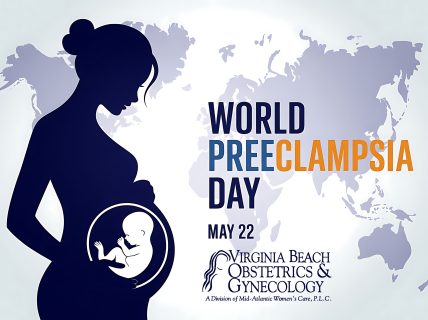World Pre-Eclampsia Day: What Every Woman Should Know

At Virginia Beach OBGYN, we are committed to raising awareness about conditions that impact maternal health—and today, on World Pre-Eclampsia Day, we want to shine a light on an often misunderstood and potentially dangerous condition: pre-eclampsia.
What Is Pre-Eclampsia?
Pre-eclampsia is a serious pregnancy complication characterized by high blood pressure and signs of damage to another organ system, often the liver and kidneys. It is sometimes referred to as toxemia. It typically occurs after the 20th week of pregnancy, but what many women and families don’t realize is that pre-eclampsia can also develop after the baby is born—a condition known as postpartum pre-eclampsia.
Pre-eclampsia is a potentially life-threatening disorder, affecting approximately 2–8 % of pregnancies worldwide and accounting for over 50,000 maternal deaths each year.
Key maternal risks of untreated pre-eclampsia include:
- Eclampsia (seizures): Progression to tonic-clonic seizures can occur rapidly and is a leading cause of maternal mortality.
- HELLP syndrome: A severe variant (Hemolysis, Elevated Liver enzymes, Low Platelets) that can lead to liver rupture, disseminated intravascular coagulation, and multi-organ failure
- Stroke and cerebral hemorrhage.
- Pulmonary edema and acute kidney injury.
- Placental abruption: Premature separation of the placenta, with risk of massive hemorrhage and shock.
- Women who survive pre-eclampsia have an elevated lifetime risk of hypertension, ischemic heart disease, stroke, and type 2 diabetes.
Key fetal risks of untreated pre-eclampsia include:
- Preterm delivery: Nearly half of pregnancies affected by pre-eclampsia (≈ 46 %) deliver prematurely.
- Intrauterine growth restriction (IUGR): Placental insufficiency limits nutrient and oxygen delivery, leading to low birth weight.
- Fetal distress and stillbirth: Severe hypertension and placental problems can deprive the fetus of oxygen.
- Long-term neurodevelopmental and metabolic consequences: Babies born after pre-eclampsia have higher risks of neurodevelopmental delay and cardiovascular disease later in life
Postpartum Pre-Eclampsia: A Hidden Risk
Pre-eclampsia doesn’t always end with delivery. Postpartum pre-eclampsia can develop up to 6 weeks after childbirth, though in some rare cases, symptoms may appear slightly later. Women who had pre-eclampsia during pregnancy are at higher risk, but postpartum pre-eclampsia can also occur in women with no prior history of the condition.
Why is this important? Because once home with a newborn, many women focus on their baby’s health while overlooking their own. Being aware of the signs and symptoms can be life-saving.
Warning Signs of Pre-Eclampsia (During and After Pregnancy)
If you are pregnant or recently delivered a baby, be alert for the following symptoms:
- Severe headaches
- Vision changes (blurry vision, seeing spots, sensitivity to light)
- Swelling in the hands, face, or eyes
- Sudden weight gain (more than 2–5 pounds in a week)
- Upper right abdominal pain
- Shortness of breath
- Nausea or vomiting (not related to a stomach bug)
- High blood pressure (140/90 or higher)
If you experience any of these symptoms, seek medical attention immediately.
Who Is at Risk?
While pre-eclampsia can affect any woman, there are some known risk factors:
• First pregnancy
• History of pre-eclampsia in a previous pregnancy
• Chronic high blood pressure
• Kidney disease
• Diabetes
• Obesity
• Age over 35
• Twin or multiple pregnancies
• Family history of pre-eclampsia
• History of in-vitro fertilization (IVF)
However, pre-eclampsia can occur in women with none of these risk factors—which is why universal awareness and early detection are so critical.
Take-home message: Pre-eclampsia is not “just high blood pressure in pregnancy.” Without timely diagnosis and treatment, it can rapidly evolve into severe, life-threatening complications for both mother and baby. Regular prenatal care, blood-pressure monitoring, and early intervention are critical to prevent these outcomes.
What You Can Do
• Attend all prenatal and postpartum checkups.
• Monitor your blood pressure regularly—during pregnancy and in the months after delivery.
• Know the warning signs and don’t hesitate to call your provider.
• Advocate for yourself: If something feels “off”, trust your instincts.
Our Commitment to You: At Virginia Beach OBGYN, our providers are here to support you every step of the way—before, during, and after pregnancy. On World Pre-Eclampsia Day, we encourage all women, partners, and families to be informed and vigilant. Together, we can reduce the risks and improve outcomes for mothers everywhere.
If you have questions or concerns about pre-eclampsia, contact our office today.
#WorldPreEclampsiaDay #MaternalHealth #VirginiaBeachOBGYN
